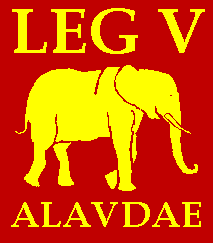
Legio II Augusta was a legion of the Imperial Roman army that was founded during the late Roman republic. Its emblems were the Capricornus, Pegasus, and Mars. It may have taken the name "Augusta" from a victory or reorganization that occurred during the reign of Augustus.

Legio V Alaudae, sometimes also known as Gallica, was a legion of the Roman army founded in 52 BC by the general Gaius Julius Caesar. It was levied in Transalpine Gaul to fight the armies of Vercingetorix, and was the first Roman legion to comprise non-citizens. Historians disagree whether the legion was destroyed during the Batavian rebellion in AD 70, or during the First Battle of Tapae.

Legio VIII Augusta was one of the oldest legions of the Imperial Roman army.
Legio I Germanica,, was a legion of the Imperial Roman army, possibly founded in 48 BC by Julius Caesar to fight for him in the civil war against Pompey. The title germanic is a reference to its service in the Germanic Wars, rather than the place of origin of its soldiers. After the Revolt of the Batavi, the remaining men of the Germanica were added to Galba's seventh legion, which became VII Gemina. The emblem of Legio I is unknown, but it was probably Taurus, like all the other legions levied by Caesar.

The Revolt of the Batavi took place in the Roman province of Germania Inferior between AD 69 and 70. It was an uprising against the Roman Empire started by the Batavi, a small but militarily powerful Germanic tribe that inhabited Batavia, on the delta of the river Rhine. They were soon joined by the Celtic tribes from Gallia Belgica and some Germanic tribes.

Legio XXII Deiotariana was a legion of the Imperial Roman army, founded ca. 48 BC and disbanded or destroyed during the Bar Kokhba revolt of 132–136. Its cognomen comes from Deiotarus, a Celtic king of Galatia. Its emblem is unknown.

Legio X Gemina, was a legion of the Imperial Roman army. It was one of the four legions used by Julius Caesar in 58 BC, for his invasion of Gaul. There are still records of the X Gemina in Vienna in the beginning of the 5th century. The legion symbol was a bull. Early on in its history, the legion was called X Equestris (mounted), because Caesar once used the legionaries as cavalry.

Legio XIII Gemina, in English the 13th Twin Legion was a legion of the Imperial Roman army. It was one of Julius Caesar's key units in Gaul and in the civil war, and was the legion with which he crossed the Rubicon in January, perhaps the 10th, 49 BC. The legion appears to have still been in existence in the 5th century AD. Its symbol was the lion.

Legio III Gallica was a legion of the Imperial Roman army. The cognomen Gallica suggests that its earliest recruits came from veterans of the Gallic legions of Gaius Julius Caesar, a supposition supported by its emblem, a bull, a symbol associated with Caesar. The legion was based for most of its existence at Raphanea, Roman Syria, and was still active in Egypt in the early 4th century.

Legio IV Scythica, also written as Legio IIII Scythica, was a legion of the Imperial Roman army founded in c. 42 BCE by the Roman general Mark Antony, for his campaign against the Parthian Empire, hence its other cognomen, Parthica. The legion was still active in the Roman province of Syria in the early 5th century.

Legio VI Victrix was a legion of the Imperial Roman army founded in 41 BC by the general Octavian. It was the twin legion of VI Ferrata and perhaps held veterans of that legion, and some soldiers kept to the traditions of the Caesarian legion.

Legio V Macedonica was a Roman legion. It was probably originally levied in 43 BC by consul Gaius Vibius Pansa Caetronianus and Gaius Iulius Caesar Octavianus. It was based in the Balkan provinces of Macedonia, Moesia and Dacia. In the Notitia Dignitatum records from beginning of the fifth century, the legion was still stationed in Dacia, with detachments stationed in the east and Egypt.

Legio VII Claudia was a legion of the Imperial Roman army.

Legio VII Gemina was a legion of the Imperial Roman army. It was raised in AD 68 in Hispania by the general Galba to take part in his rebellion against the emperor Nero. "Gemina" means the legion was dedicated to the legendary twin founders of Rome, Romulus and Remus, who were suckled by a she-wolf. The legion was deployed in the city called Legio in AD 74 and remained in Hispania to the end of the 4th century.
Legio XVI Gallica was a legion of the Imperial Roman army. The legion was recruited by Julius Caesar's adopted son, Octavian in 41/40 BC. It was disbanded after surrendering during the Batavian rebellion ; Emperor Vespasian created a new legion, the XVI Flavia Firma.

The National Roman Legion Museum (Wales) is a museum in Caerleon, near Newport, south-east Wales. It is one of three Roman sites in Caerleon, along with the Baths museum and the open-air ruins of the amphitheatre and barracks. It is part of the wider network of Amgueddfa Cymru – Museum Wales.
Gallica, the digital library of the Bibliothèque nationale de France.
The Third Legion can refer any of these Roman Legions:





